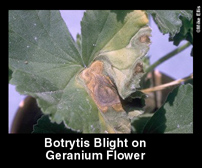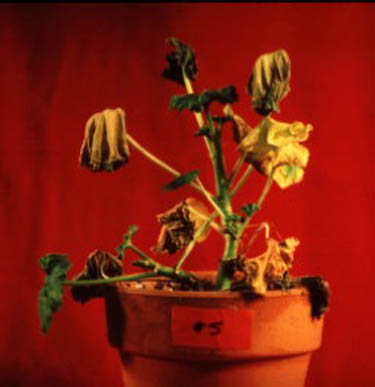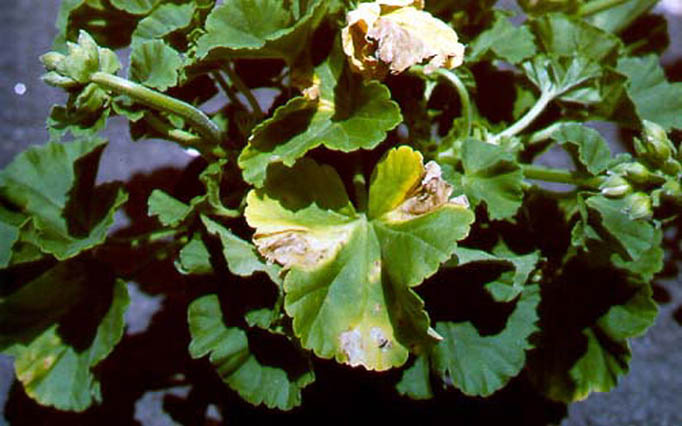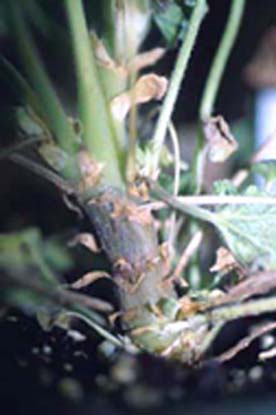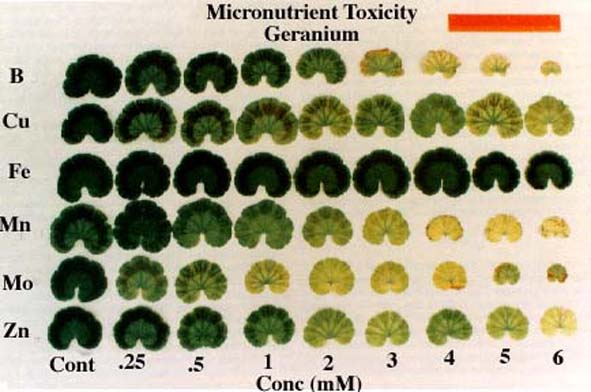Botrytis
Botrytis gray mold is caused by the fungus Botrytis cinerea. This is a common fungus in the greenhouse and can survive in the greenhouse year round as conidia, mycelium, or sclerotia on living or dead plant material. The fungus is very active and rapidly reproduces when relative humidity is at or above 85%, with little or no air circulation. The optimum air temperature for germination is between 72 and 77 degrees F. The most common was that the fungus penetrates the living tissue is through wounds in the plants from broken stems, damaged leaves from transport, or from cuttings that were harvested. The easiest way to control this disease is through cultural practices. These practices include cleaning up waste around the growing areas including leaves, soil, and removal of excess water that adds to relative humidity. By improving air circulation with Horizontal Air Flow (HAF) fans, the leaves of the plants will dry faster and not be as susceptible to infestation. Chemical treatments of Cleary's 3336, Chipco 26019, and Daconil 2787 are effective but should be used only when needed. Over use of these chemicals can possibly lead to resistance by the fungus. Botrytis on the flower of a Geranium will greatly reduce the appearance of the flower and will result in lower sales for the greenhouse owner.
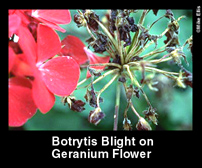
Bacterial Wilt
Bacterial Wilt or blight of Geranium is caused by Xanthomonas campestris pv. pelargonii. This is the most destructive disease associated with greenhouse geranium production today. The bacterium enter the geranium through wounds and natural openings. Once inside the geranium, the bacteria multiplies and spread systemically through the plants vascular system. As the bacteria multiplies it literally plugs up the vascular system and causes the plant to wilt due to lack of water transported up to the leaves of the plant. If the infected plant goes undetected for just a short time, the bacteria can spread plant to plant and infect an entire crop. The V-shaped lesions on the leaves of infected plants are one way of determining if you have a possible infection of Xanthomonas. There are no varieties resistant to Xanthomonas so the only true way of controlling the disease is to keep it out of the greenhouse. The purchase of or production of Xanthomonas free plant material is key to keeping the greenhouse free of this disease. If infected plants are allowed to enter the greenhouse, you will need to pay very close attention to the handling and watering of the plants to minimize the spread of the disease.
Black Leg
The Black Leg disease is caused by the fungal pathogen Pythium sp. Pythium is very commonly found in greenhouses where bedding plants are grown. Pythium is normally associated with various root rots of poinsettias, petunias, impatiens, and geraniums. In geraniums, pythium can infect the roots when the media conditions are extremely saturated. The fungus initially attacks the root tips and works its way into the way up to the crown of the plant through the vascular system. Black Leg can attack at any stage of development. When the symptoms appear it is usually too late and any healthy roots are dead by the time you notice the problem. The best way to control this disease is by not letting it enter your greenhouse. Since Black leg is an advanced type of Pythium Root Rot, the controls that you have in place for control of root rots will also help in the control of Black Leg. The use of good sanitation and cultural practices of cleaning the work area after each use is also very helpful in the prevention of Black Leg. Chemical applications of Subdue MAXX, Banrot, and Heritage are effective in the prevention of Black Leg and are needed to be applied before the onset of Black Leg.
Iron and Micronutrient Toxicity
Although not a disease, Iron and Micronutrient toxicity can be a serious problem to a geranium producer. The best way to control this problem is to regularly check the pH, EC, and Alkalinity of the irrigation water and fertilizer solution weekly. Also measure the media pH and EC fresh out of the bag and weekly from samples throughout the greenhouse to find any possible trends. After a few years of collecting data, you should be able to find trends in the measurements if any are there. For example, if the greenhouse is located in a rural area that is surrounded by farm fields, the irrigation water might have fluctuations in the pH and EC due to applications of fertilizers and other chemicals to the adjacent fields. If the grower finds these types of trends then he can adjust his irrigation waters pH and EC accordingly to compensate. A chart showing different types micronutrient toxicity and their affects on the leaves.
